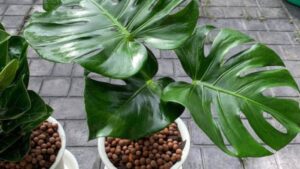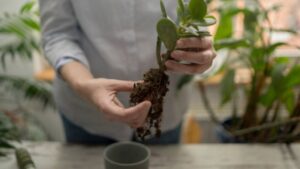Split leaf philodendrons are more than just houseplants; they’re a statement piece in any indoor space. With their large, deeply lobed leaves, these tropical wonders not only bring a touch of the rainforest indoors but also contribute to a healthier living environment. Let’s embark on a comprehensive journey to master the art of split leaf philodendron care.
Choosing the Right Location

Ensuring the well-being of your Split Leaf Philodendron starts with the careful selection of its abode. The key to a thriving plant lies in finding the perfect spot where it can bask in bright, indirect light—emulating the lush, shaded ambiance it naturally craves beneath the canopy. Optimal conditions are met in a room adorned with east or west-facing windows, striking the right balance of sunlight without subjecting your green companion to the harshness of direct rays.
Crafting an environment akin to the warm, tropical climate these beauties adore requires attention to temperature nuances. Maintain a consistent range of 65°F to 80°F (18°C to 27°C) to ensure your Split Leaf Philodendron feels right at home. Shield it from drafts and abrupt temperature changes, as these can induce stress upon the plant, hindering its growth.
Bear in mind that these care recommendations serve as a general guide. Tuning into your plant’s cues and making subtle adjustments tailored to its unique needs will be your compass for creating the perfect haven. Now, let’s delve into the intricacies of Split Leaf Philodendron Care.
Watering Techniques
Watering is a critical aspect of split leaf philodendron care, and finding the right balance is essential. These plants prefer their soil to dry out partially between watering sessions. Stick your finger into the soil; if it feels dry about an inch deep, it’s time to water.

Use room temperature water and ensure that excess water can drain freely from the pot. Waterlogged soil can lead to root rot, a common issue with philodendrons. Consider using a pot with drainage holes and a well-draining soil mix to facilitate proper water management.
During the growing season (spring and summer), you’ll likely water more frequently than in the dormant season (fall and winter). Adjust your watering schedule accordingly to accommodate the plant’s changing needs throughout the year.
Maintaining this balance not only prevents overwatering issues but also promotes healthy root development and overall plant vitality.
Fertilizing Guidelines For Split Leaf Philodendron Care
Nourishing your Split Leaf Philodendron is akin to crafting a meticulous care regimen, and integral to this routine is the art of Split Leaf Philodendron Care. Much like providing a balanced diet, opt for a liquid fertilizer that boasts a harmonious NPK ratio—nitrogen, phosphorus, and potassium—to cater to your plant’s essential nutritional needs, promoting robust growth and ensuring vibrant foliage.

Throughout the active growing seasons, typically spring and summer, embrace a feeding schedule every 2-4 weeks. However, exercise caution by diluting the fertilizer to half the recommended strength to sidestep the pitfalls of over-fertilizing, a practice that may result in detrimental salt buildup within the soil.
As fall and winter usher in the dormant phase, it’s time to adjust your nurturing approach. Consider reducing or halting fertilization altogether during this period, allowing your plant the respite it needs to recharge for the upcoming growing season.
Remember, the act of fertilizing should be viewed as a supplement to the overarching philosophy of proper care, never a substitute. Navigate this delicate balance by adhering to the recommended dosage on the fertilizer packaging, and, most importantly, attune your regimen to the specific needs of your plant. So, let’s delve deeper into the intricate world of Split Leaf Philodendron Care and uncover the secrets to fostering a flourishing foliage companion.

Repotting Tips
Repotting is a crucial aspect of split leaf philodendron care, ensuring that your plant has enough space for healthy growth. Signs that your philodendron needs repotting include roots emerging from drainage holes or the plant outgrowing its current container.

When ready to repot, follow these step-by-step guidelines:
- Choose the Right Time: Spring is the ideal time for repotting, as the plant enters its active growing phase. This allows it to recover and establish in its new home.
- Select the Right Pot: Opt for a pot that is 1-2 inches larger in diameter than the current one. Ensure it has drainage holes to prevent waterlogging.
- Prepare the Soil: Use a well-draining potting mix. You can add perlite or orchid bark to enhance drainage.
- Gently Remove the Plant: Water the plant a day before repotting to make the soil more pliable. Carefully tilt the pot and slide out the plant, avoiding damage to the roots.
- Inspect and Trim Roots: Check for any rotting or unhealthy roots and trim them with sterilized scissors. This stimulates new root growth.
- Place in the New Pot: Position the plant in the center of the new pot, filling the sides with fresh soil. Ensure the top of the root ball sits slightly below the rim of the pot.
- Water Thoroughly: Give the plant a thorough watering to help settle the soil and hydrate the roots.
- Monitor and Care: Keep a close eye on your philodendron post-repotting. Limit direct sunlight for a few days to reduce stress, allowing the plant to acclimate to its new environment.
Pruning for Health and Aesthetics
Pruning is both an art and a science in split leaf philodendron care. It not only maintains the plant’s shape but also encourages new growth and removes any damaged or diseased parts.
Follow these guidelines for effective pruning:
- Timing is Everything: Prune during the growing season for optimal results. Spring and early summer are ideal.
- Identify the Nodes: Prune just above a leaf node to encourage branching. Nodes are the points on the stem where leaves and buds emerge.
- Remove Yellow or Damaged Leaves: Trim any yellowing or damaged leaves to redirect the plant’s energy towards healthy foliage.
- Shape and Size: If your philodendron is becoming too large or unruly, shape it by cutting back stems to the desired length. This not only maintains aesthetics but also prevents overcrowding.
- Sterilize Your Tools: Always use clean, sharp scissors or pruning shears to prevent the spread of diseases. Sterilize them with rubbing alcohol before and after each use.
- Step Back and Assess: Don’t be afraid to step back and assess your pruning decisions as you go. This allows you to maintain a balanced and aesthetically pleasing shape.
By incorporating regular pruning into your split leaf philodendron care routine, you promote a healthier and more vibrant plant.
Pest Management
In the realm of Split Leaf Philodendron Care, resilience is key, yet these hardy plants can face pests like spider mites, scale insects, and aphids. Vigilance and prevention are vital—regularly inspect and introduce natural predators like ladybugs. If pests persist, use organic insecticidal soaps or neem oil. Join me in exploring the essentials of Split Leaf Philodendron Care, balancing growth and defense for a flourishing plant.
- Inspect Regularly: Regularly inspect the leaves, both upper and lower surfaces, for signs of pests. Look out for webbing, discoloration, or small moving specks.
- Natural Remedies: For early infestations, consider natural remedies like neem oil or insecticidal soap. These options are less harmful to your plant and the environment.
- Isolate Affected Plants: If you notice pests on one plant, isolate it from others to prevent the infestation from spreading.
- Commercial Insecticides: In severe cases, consider commercial insecticides. Always follow the instructions carefully and avoid using them on stressed or newly repotted plants.
- Maintain a Clean Environment: Regularly clean the leaves with a damp cloth to remove dust, which can attract pests. Keep the surrounding area free from debris and fallen leaves.
Remember, early detection is key in pest management. Regularly inspecting your split leaf philodendron allows you to address issues promptly, ensuring the health of your plant.
Common Issues and Troubleshooting
Even with the best care, split leaf philodendrons may encounter challenges. Let’s explore common issues and troubleshooting tips:
- Yellowing Leaves:
- Overwatering: Adjust your watering schedule if you notice yellowing leaves. Allow the soil to dry out between waterings to prevent root rot.
- Nutrient Deficiency: Ensure your plant is receiving adequate nutrients through proper fertilization.
- Root Rot Prevention:
- Well-Draining Soil: Use a well-draining potting mix to prevent waterlogged soil.
- Proper Watering: Allow the top inch of soil to dry before watering again.
Addressing potential challenges promptly is a cornerstone of successful Split Leaf Philodendron Care, ensuring your plant remains in optimal condition with robust growth and vibrant foliage. Staying attuned to the nuances of Split Leaf Philodendron Care allows you to navigate potential hurdles gracefully, fostering a flourishing environment for your verdant companion.
Enhancing Humidity
Crafting an environment conducive to Split Leaf Philodendron Care involves prioritizing humidity, a vital factor in the well-being of these plants. Here are some effective methods to elevate humidity and ensure optimal conditions for your split leaf philodendron to thrive:
- Misting: Regularly mist the leaves with water to increase ambient humidity. Focus on the undersides of the leaves where the stomata are located.
- Humidity Tray: Place a tray filled with water and pebbles near the plant. As the water evaporates, it raises the humidity around the plant.
- Grouping Plants: Grouping plants together creates a microclimate with higher humidity levels.
- Use a Humidifier: If you live in a dry climate, consider using a humidifier to maintain consistent humidity levels.
Implementing these thoughtful methods is not just a care routine; it’s a symphony of measures harmonized for the well-being of your split leaf philodendron. By doing so, you emulate the humid conditions of its native habitat, a cornerstone of effective Split Leaf Philodendron Care. The result? A plant that thrives, embodying the essence of health and happiness in your care.
Propagation Techniques For Split Leaf Philodendron
Embarking on the journey of expanding your split leaf philodendron collection is an exhilarating pursuit. Here’s a step-by-step guide to successful propagation, an essential point in the comprehensive article of Split Leaf Philodendron Care:
- Choose Healthy Parent Plant: Select a mature and healthy plant for propagation. Healthy parent plants are more likely to produce strong, viable offspring.
- Select Propagation Method:
- Air Layering: This involves creating a small incision in a stem, wrapping it with moist sphagnum moss, and then covering it with plastic wrap. Once roots develop, you can cut and plant the new rooted section.
- Stem Cuttings: Take a cutting of a healthy stem with at least two nodes. Remove any leaves near the bottom and place the cutting in water or a rooting medium until roots develop.
- Provide Adequate Conditions: Keep the cutting in a warm, humid environment with indirect light. Regularly mist the cutting to maintain moisture levels.
- Potting the New Plant: Once the roots are well-established, transplant the new plant into a well-draining potting mix.
Propagation is not only a fantastic way to expand your collection but also a means of rejuvenating an aging plant. Experiment with different methods to find the one that works best for you.
Decorative Tips
Elevating your indoor aesthetic becomes an artful expression when you seamlessly integrate split leaf philodendrons into your decor. Here are some creative ideas to infuse your space with the lush allure of these plants, coupled with tips to ensure their well-being through thoughtful Split Leaf Philodendron Care:

- Stylish Pots:
- Choose decorative pots that complement your interior design.
- Opt for pots with drainage holes to maintain optimal soil conditions.
- Unique Arrangements:
- Mix and match with other houseplants for a diverse and visually appealing display.
- Experiment with different heights and textures for an eye-catching arrangement.
Infusing style into your split leaf philodendron presentation is a delightful way to elevate both your living space and the inherent beauty of these stunning plants. This aesthetic enhancement, coupled with dedicated Split Leaf Philodendron Care, allows you to showcase these green wonders in all their glory, creating a harmonious blend of visual appeal and optimal plant well-being.
Seasonal Care
Harmonizing your care routine with the changing seasons is essential for ensuring the overall health and well-being of your split leaf philodendron. Join me as we delve into the nuanced adjustments required during different times of the year, unveiling the artistry behind adeptly managing Split Leaf Philodendron Care throughout the seasons.
Spring and Summer
- Increased Watering:
- With the plant entering its active growth phase, you’ll likely need to water more frequently.
- Monitor soil moisture and adjust accordingly, ensuring it doesn’t dry out completely.
- Fertilize Regularly:
- Provide regular feedings with a balanced liquid fertilizer to support vigorous growth.
- Dilute the fertilizer to half the recommended strength to prevent over-fertilization.
- Pruning and Shaping:
- Spring is an ideal time for pruning to encourage new growth and shape your plant.
- Remove any damaged or unwanted growth to maintain a visually appealing form.
Fall and Winter
- Reduced Watering:
- As the plant enters a dormant phase, reduce the frequency of watering.
- Allow the top inch of soil to dry out before considering the next watering.
- Limited Fertilization:
- Scale back on fertilization or cease entirely during the dormant season.
- This allows the plant to rest and conserve energy for the upcoming growth period.
- Protect from Drafts:
- Place your split leaf philodendron away from drafts or cold windows during winter to prevent stress.
In the delicate dance of tending to your split leaf philodendron, understanding and adapting your care routine to the ebb and flow of the changing seasons are pivotal. This thoughtful approach ensures that your plant receives the tailored conditions it requires at different stages of the year, fostering not only its immediate health but also promoting overall vitality and longevity. Dive into the nuances of Split Leaf Philodendron Care and witness the flourishing results of a well-seasoned care regimen.
Benefits of Split Leaf Philodendrons
Beyond the captivating aesthetics they bring to your indoor spaces, split leaf philodendrons offer a plethora of benefits that make them an excellent choice. Dive into the world of Split Leaf Philodendron Care, where the beauty of these plants intertwines seamlessly with the advantages they bring to enhance your living environment.
- Air-Purifying Qualities:
- These plants are known for their ability to remove toxins from the air, contributing to a healthier indoor environment.
- They help filter out pollutants, providing cleaner and fresher air for you to breathe.
- Aesthetic Appeal:
- With their large, lobed leaves and striking appearance, split leaf philodendrons add a touch of tropical elegance to any room.
- They serve as focal points in your decor, making a bold statement.

By recognizing and appreciating these inherent benefits, you’ll not only enjoy the visual beauty of your split leaf philodendron but also embrace the positive impact it has on your living space. Delving into the intricacies of Split Leaf Philodendron Care unveils a symbiotic relationship, where the plant’s aesthetic allure converges seamlessly with the holistic enhancements it brings to your indoor environment.
Common Myths and Misconceptions
Embarking on a journey to dispel common myths and misconceptions surrounding split leaf philodendrons opens a gateway to a deeper understanding. Join me in unraveling the truths and nuances of Split Leaf Philodendron Care, debunking misconceptions that may have lingered in the foliage of gardening lore.
- High Maintenance:
- While they may seem exotic, split leaf philodendrons are surprisingly low-maintenance.
- With proper care, they can thrive in indoor environments with ease.
- Toxicity Concerns:
- Contrary to popular belief, split leaf philodendrons are not highly toxic.
- While it’s essential to keep them out of reach of pets and small children, their toxicity is generally mild.
- Limited Indoor Adaptability:
- These plants are adaptable to indoor conditions, provided you meet their basic care requirements.
- With proper lighting, watering, and humidity, they can flourish in homes.
By dispelling these myths, you gain a more accurate understanding of split leaf philodendrons, empowering you to care for them effectively without unnecessary concerns.
Conclusion
In conclusion, mastering split leaf philodendron care involves a harmonious blend of attention to detail and understanding the unique needs of these tropical wonders. From choosing the right location to adapting your care routine with the seasons, you’ve embarked on a comprehensive journey to ensure your split leaf philodendron thrives.
Frequently Asked Questions (FAQs)
How do I know if my split leaf philodendron is getting enough light?
In the careful orchestration of Split Leaf Philodendron Care, paying attention to the color of the leaves becomes a symphony of clues. Healthy split leaf philodendrons boast vibrant green leaves, signaling their contentment. However, a change to a pale or yellowish hue may reveal a need for more light, unraveling the subtleties within Split Leaf Philodendron Care. On the flip side, leaves showing signs of scorching or browning may be an indicator of excessive direct sunlight, prompting a delicate recalibration of their environmental conditions.
Can I use tap water for my split leaf philodendron?
While tap water is generally suitable, it’s essential to let it sit for 24 hours before using it. This allows chlorine to dissipate, preventing potential harm to the plant. Alternatively, using filtered or distilled water is a safe option.
What’s the ideal humidity level for split leaf philodendrons?
Aim for a humidity level between 60-80%. While these plants can tolerate lower humidity, providing higher humidity replicates their natural habitat and promotes optimal growth.
How do I encourage my split leaf philodendron to bloom?
Split leaf philodendrons are primarily foliage plants and are not known for prolific flowering indoors. However, providing a well-balanced fertilizer during the growing season can encourage occasional blooms. Focus on the lush foliage, as that’s the main attraction.
Why are the leaves of my split leaf philodendron turning brown at the edges?
This is often a sign of low humidity. Increase humidity by misting the leaves or using humidity trays. Ensure the plant is not placed near drafts, heaters, or air conditioning vents, as these can contribute to dry conditions.
Is a split leaf philodendron easy to grow?
Yes, split leaf philodendrons are generally considered easy to grow, making them a popular choice for indoor plant enthusiasts.


